Investigations on the Johnson-Cook Constitutive and Damage-Fracture Model Parameters of a Q345C Steel
Abstract
:1. Introduction
2. Experimental Results and Discussion
2.1. Johnson-Cook Constitutive Model
2.2. Johnson-Cook Damage-Fracture Model
2.3. Experimental Materials, Samples, and Setups
3. Results and Discussions
3.1. Strain Rate Effect and A, B, n, C, and
3.2. Temperature Effect and m,
3.3. Loading Path Effect and –
3.4. Parameter Validation
4. Conclusions
Author Contributions
Funding
Data Availability Statement
Conflicts of Interest
References
- Mengge, Y.; Jiye, Z.; Weihua, Z. Operational Safety Reliability of High-Speed Trains under Stochastic Winds. Chin. J. Theor. Appl. Mech. 2013, 45, 483–492. [Google Scholar]
- Chunlan, W.; Yuxin, S.; Chen, L. Safety Assessment and Risk Control of High-Speed Trains Passenger Transportation. China Saf. Sci. J. 2019, 29, 150. [Google Scholar]
- Guo, W.; Xia, H.; Karoumi, R.; Zhang, T.; Li, X. Aerodynamic Effect of Wind Barriers and Running Safety of Trains on High-Speed Railway Bridges under Cross Winds. Wind Struct. 2015, 20, 213–236. [Google Scholar] [CrossRef]
- Jin, X.; Xiao, X.; Ling, L.; Xiong, J. Study on Safety Boundary for High-Speed Train Running in Severe Environments. Int. J. Rail Transp. 2013, 1, 87–108. [Google Scholar] [CrossRef]
- Cai, C.; Zhao, C.; Luo, Q.; Xie, Y.; Xia, H.; Li, G.; Song, X.; Zhai, W. Basic scientific issues on dynamic performance evolution of the high-speed railway infrastructure and its service safety. Sci. Sin.-Tech. 2014, 44, 645–660. [Google Scholar] [CrossRef]
- Wu, W.; Liu, Q.; Zong, Z.; Sun, G.; Li, Q. Experimental Investigation into Transverse Crashworthiness of CFRP Adhesively Bonded Joints in Vehicle Structure. Compos. Struct. 2013, 106, 581–589. [Google Scholar] [CrossRef]
- Zhu, T.; Xiao, S.-N.; Hu, G.-Z.; Yang, G.-W.; Yang, C. Crashworthiness Analysis of the Structure of Metro Vehicles Constructed from Typical Materials and the Lumped Parameter Model of Frontal Impact. Transport 2019, 34, 75–88. [Google Scholar] [CrossRef]
- Chen, Y.; Cheng, X.; Fu, K. Multi-Material Design of a Vehicle Body Considering Crashworthiness Safety and Social Effects. Int. J. Crashworthiness 2019, 25, 517–526. [Google Scholar] [CrossRef]
- Temel, S.; Vuran, M.C.; Lunar, M.M.; Zhao, Z.; Salam, A.; Faller, R.K.; Stolle, C. Vehicle-to-Barrier Communication during Real-World Vehicle Crash Tests. Comput. Commun. 2018, 127, 172–186. [Google Scholar] [CrossRef]
- Basith, M.A.; Reddy, N.C.; Uppalapati, S.; Jani, S. Crash Analysis of a Passenger Car Bumper Assembly to Improve Design for Impact Test. Mater. Today Proc. 2021, 45, 1684–1690. [Google Scholar] [CrossRef]
- Zhou, D.; Li, R.; Wang, J.; Guo, C. Study on Impact Behavior and Impact Force of Bridge Pier Subjected to Vehicle Collision. Shock Vib. 2017, 2017, 7085392. [Google Scholar] [CrossRef]
- Nanda, T.; Singh, V.; Singh, G.; Singh, M.; Kumar, B.R. Processing Routes, Resulting Microstructures, and Strain Rate Dependent Deformation Behaviour of Advanced High Strength Steels for Automotive Applications. Archiv. Civ. Mech. Eng. 2021, 21, 7. [Google Scholar] [CrossRef]
- Jia, N.; Zhang, H.; Liu, X.; Cai, M. Research on Fire Resistance of Stainless Steel Car Body Floor Structure in Urban Rail Vehicles. In Proceedings of the IMECE2020, International Mechanical Engineering Congress and Exposition, Online, 16 November 2020. Volume 6: Design, Systems, and Complexity. [Google Scholar]
- Song, I.-H.; Kim, J.-W.; Koo, J.-S.; Lim, N.-H. Modeling and Simulation of Collision-Causing Derailment to Design the Derailment Containment Provision Using a Simplified Vehicle Model. Appl. Sci. 2019, 10, 118. [Google Scholar] [CrossRef]
- Tang, Z.; Zhu, Y.; Nie, Y.; Guo, S.; Liu, F.; Chang, J.; Zhang, J. Data-Driven Train Set Crash Dynamics Simulation. Veh. Syst. Dyn. 2017, 55, 149–167. [Google Scholar] [CrossRef]
- Cole, C.; Spiryagin, M.; Wu, Q.; Sun, Y.Q. Modelling, Simulation and Applications of Longitudinal Train Dynamics. Veh. Syst. Dyn. 2017, 55, 1498–1571. [Google Scholar] [CrossRef]
- Johnson, G. A Constitutive Model and Date for Metals Subject to Large Strains, High Strain Rate and High Temperatures. In Proceedings of the 7th International Symposium on Ballistics, The Hague, The Netherlands, 19–21 April 1983. [Google Scholar]
- Kumar Reddy Sirigiri, V.; Yadav Gudiga, V.; Shankar Gattu, U.; Suneesh, G.; Mohan Buddaraju, K. A Review on Johnson Cook Material Model. Mater. Today Proc. 2022, 62, 3450–3456. [Google Scholar] [CrossRef]
- Jutras, M. Improvement of the Characterisation Method of the Johnson-Cook Model. Master’s Thesis, Université Laval, Québec, QC, Canada, 2008. [Google Scholar]
- Zhu, H.; Zhang, C.; Chen, S.; Wu, J. A Modified Johnson-Cook Constitutive Model for Structural Steel after Cooling from High Temperature. Constr. Build. Mater. 2022, 340, 127746. [Google Scholar] [CrossRef]
- Li, H.; Li, F.; Zhang, R.; Zhi, X. High Strain Rate Experiments and Constitutive Model for Q390D Steel. J. Constr. Steel Res. 2023, 206, 107933. [Google Scholar] [CrossRef]
- Zhang, D.-N.; Shangguan, Q.-Q.; Xie, C.-J.; Liu, F. A Modified Johnson–Cook Model of Dynamic Tensile Behaviors for 7075-T6 Aluminum Alloy. J. Alloys Compd. 2015, 619, 186–194. [Google Scholar] [CrossRef]
- Yu, W.; Zhao, J.; Shi, J. Dynamic Mechanical Behaviour of Q345 Steel at Elevated Temperatures: Experimental Study. Mater. High Temp. 2010, 27, 285–293. [Google Scholar] [CrossRef]
- Sahu, S.; Pada Mondal, D.; Dass Goel, M.; Mohd, Z.A. Finite Element Analysis of AA1100 Elasto-Plastic Behaviour Using Johnson-Cook Model. Mater. Today Proc. 2018, 5, 5349–5353. [Google Scholar] [CrossRef]
- Saxena, A.; Dwivedi, S.P.; Kumaraswamy, A.; Srivastava, A.K.; Maurya, N.K. Influence of SD Effect on Johnson–Cook Hardening Constitutive Material Model: Numerical and Experimental Investigation for Armor Steel. Mech. Adv. Mater. Struct. 2022, 29, 285–302. [Google Scholar] [CrossRef]
- Shrot, A.; Bäker, M. Determination of Johnson–Cook Parameters from Machining Simulations. Comput. Mater. Sci. 2012, 52, 298–304. [Google Scholar] [CrossRef]
- Korkmaz, M.E. Verification of Johnson-Cook Parameters of Ferritic Stainless Steel by Drilling Process: Experimental and Finite Element Simulations. J. Mater. Res. Technol. 2020, 9, 6322–6330. [Google Scholar] [CrossRef]
- Zhou, J.; Liu, J.; Zhang, X.; Yan, Y.; Jiang, L.; Mohagheghian, I.; Dear, J.P.; Charalambides, M.N. Experimental and Numerical Investigation of High Velocity Soft Impact Loading on Aircraft Materials. Aerosp. Sci. Technol. 2019, 90, 44–58. [Google Scholar] [CrossRef]
- Liu, P.; Quan, Y.; Ding, G. Dynamic Mechanical Characteristics and Constitutive Modeling of Rail Steel over a Wide Range of Temperatures and Strain Rates. Adv. Mater. Sci. Eng. 2019, 2019, 6862391. [Google Scholar] [CrossRef]
- Zhao, G.; Tian, Y.; Song, Y.; Li, J.; Li, H.; Zhang, J. A Comparative Study of Three Constitutive Models Concerning Thermo-Mechanical Behavior of Q345 Steel during Hot Deformation. Crystals 2022, 12, 1262. [Google Scholar] [CrossRef]
- Wang, X.; Shi, J. Validation of Johnson-Cook Plasticity and Damage Model Using Impact Experiment. Int. J. Impact Eng. 2013, 60, 67–75. [Google Scholar] [CrossRef]
- He, B.L.; Yu, Y.X.; Liu, J. Research and Prospects of Improving the Fatigue Life of Wleded Train Bogie Structure. Adv. Mater. Res. 2011, 189, 3292–3295. [Google Scholar]
- Qin, Y.; Yao, X.; Wang, Z.; Wang, Y. Experimental Investigation on Damage Features of Stiffened Cabin Structures Subjected to Internal Blast Loading. Ocean Eng. 2022, 265, 112639. [Google Scholar] [CrossRef]
- Wu, Y.S.; Liu, Y.J. Study on Ductile Brittle Transition Temperature of Q345C Steel MAG Welded Joints. Key Eng. Mater. 2016, 703, 155–159. [Google Scholar]
- Ma, C.; Fu, H.; Lu, P.; Lu, H. Multi-Objective Crashworthiness Design Optimization of a Rollover Protective Structure by an Improved Constraint-Handling Technique. AIMS Press 2023, 31, 4278–4302. [Google Scholar] [CrossRef]
- Liu, C.; Hao, E.; Zhang, S. Optimization and Application of a Crashworthy Device for the Monopile Offshore Wind Turbine against Ship Impact. Appl. Ocean Res. 2015, 51, 129–137. [Google Scholar] [CrossRef]
- Wang, D.; Xu, P.; Yang, C.; Yao, S.; Liu, Z. Crashworthiness Performance of Gradient Energy-Absorbing Structure for Subway Vehicles under Quasi-Static Loading. AIMS Press 2023, 31, 3568–3593. [Google Scholar] [CrossRef]
- Sun, H.; Ma, Y.; Cai, Q.; Zhou, G.; Duan, Y.; Zhang, M. Study on the Effect of Impact on the Macro-and Micro-Structure of Q345 Steel Plate. J. Mater. Eng. Perform. 2023, 1–15. [Google Scholar] [CrossRef]
- Lin, Z.; Zihao, W.; Heming, W. On the Accuracy of the Johnson-Cook Constitutive Model for Metals. Chin. J. High Press. Phys. 2019, 33, 1. [Google Scholar]
- Johnson, G.R.; Cook, W.H. Fracture Characteristics of Three Metals Subjected to Various Strains, Strain Rates, Temperatures and Pressures. Eng. Fract. Mech. 1985, 21, 31–48. [Google Scholar] [CrossRef]
- Quanjin, M.; Rejab, M.; Halim, Q.; Merzuki, M.; Darus, M. Experimental Investigation of the Tensile Test Using Digital Image Correlation (DIC) Method. Mater. Today Proc. 2020, 27, 757–763. [Google Scholar] [CrossRef]
- Wang, L.; Hu, S.; Yang, L.; Sun, Z.; Zhu, J.; Lai, H.; Ding, Y. Development of Experimental Methods for Impact Testing by Combining Hopkinson Pressure Bar with Other Techniques. Acta Mech. Solida Sin. 2014, 27, 331–344. [Google Scholar] [CrossRef]
- Dou, Q.; Wu, K.; Suo, T.; Zhang, C.; Guo, X.; Guo, Y.; Guo, W.; Li, Y. Experimental Methods for Determination of Mechanical Behaviors of Materials at High Temperatures via the Split Hopkinson Bars. Acta Mech. Sin. 2020, 36, 1275–1293. [Google Scholar] [CrossRef]
- GB/T 228.1-2021; Metallic Materials—Tensile Testing—Part 1: Method of Test at Room Temperature. Standards Press of China: Beijing, China, 2021.
- Wu, X.; Wang, X.; Wei, Y.; Song, H.; Huang, C. An Experimental Method to Measure Dynamic Stress–Strain Relationship of Materials at High Strain Rates. Int. J. Impact Eng. 2014, 69, 149–156. [Google Scholar] [CrossRef]
- Wang, Y.; Zhou, H.; Shi, Y.; Chen, H. Study on Fracture Toughness Indices of Chinese Structural Steel and Weld Metal. In Proceedings of the ISOPE International Ocean and Polar Engineering Conference, Beijing, China, 20–25 June 2010; p. ISOPE-I. [Google Scholar]
- Gutiérrez, I. Effect of Microstructure on the Impact Toughness of Nb-Microalloyed Steel: Generalisation of Existing Relations from Ferrite–Pearlite to High Strength Microstructures. Mater. Sci. Eng. A 2013, 571, 57–67. [Google Scholar] [CrossRef]
- Wang, M.; Zhang, F.; Yang, Z. Effects of High-Temperature Deformation and Cooling Process on the Microstructure and Mechanical Properties of an Ultrahigh-Strength Pearlite Steel. Mater. Des. 2017, 114, 102–110. [Google Scholar] [CrossRef]
- Liu, W.; Lian, J. Stress-State Dependence of Dynamic Strain Aging: Thermal Hardening and Blue Brittleness. Int. J. Miner. Metall. Mater. 2021, 28, 854–866. [Google Scholar] [CrossRef]
- Song, Y.; Wang, S.; Zhao, G.; Li, Y.; Juan, L.; Jian, Z. Hot Deformation Behavior and Microstructural Evolution of 2205 Duplex Stainless Steel. Mater. Res. Express 2020, 7, 046510. [Google Scholar] [CrossRef]
- Gang, C.; Chen, Z.; Tao, J.; Niu, W.; Zhang, Q.; Huang, X. Investigation and Validation on Plastic Constitutive Parameters of 45 Steel. J. Vib. Shock 2005, 25, 451–456. [Google Scholar]
- Gang, C.; Chen, Z.; Xu, W.; Chen, Y.; Huang, X. Investigation on the J-C Ductile Fracture Parameters of 45 Steel. J. Vib. Shock 2007, 27, 131–135. [Google Scholar]
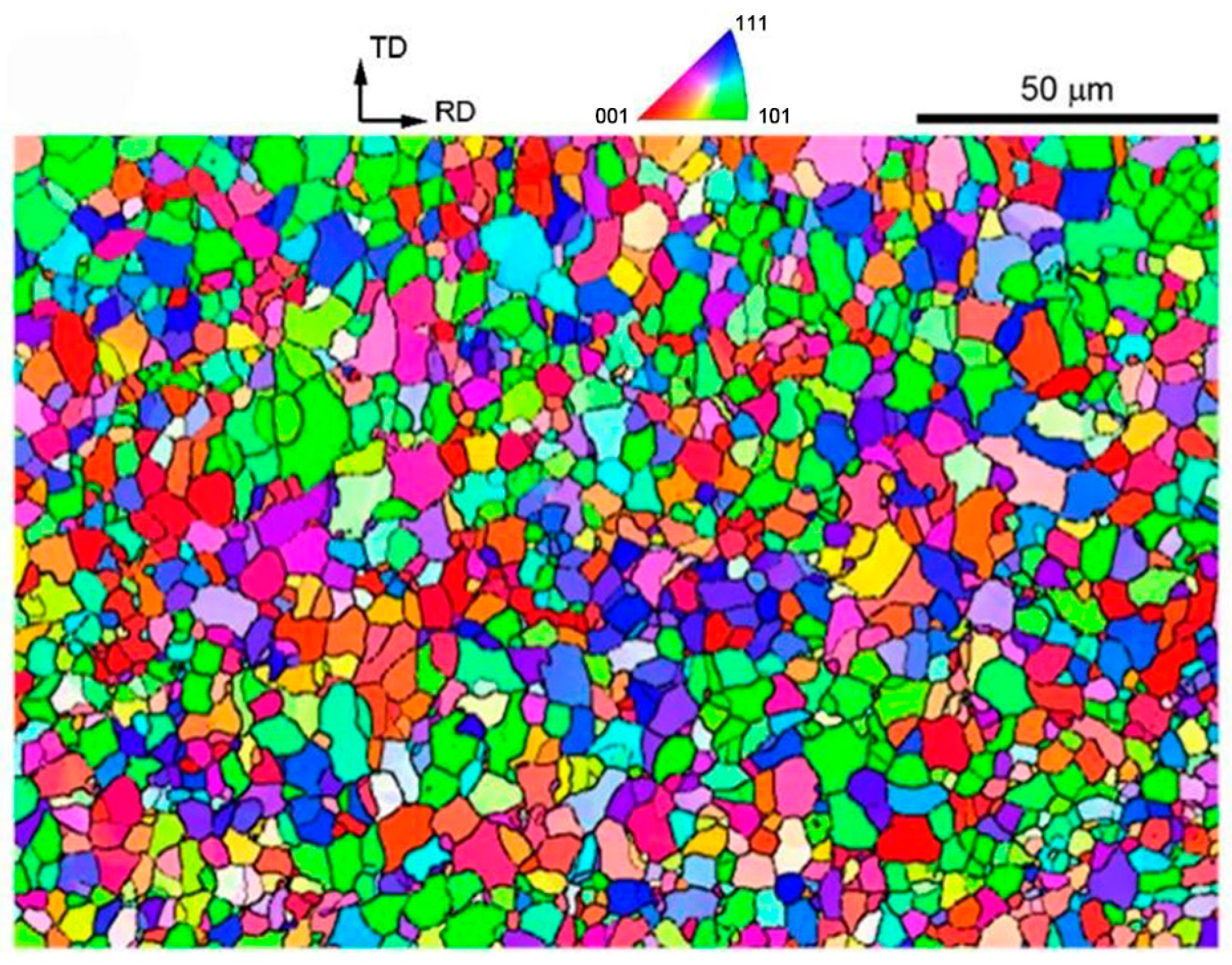

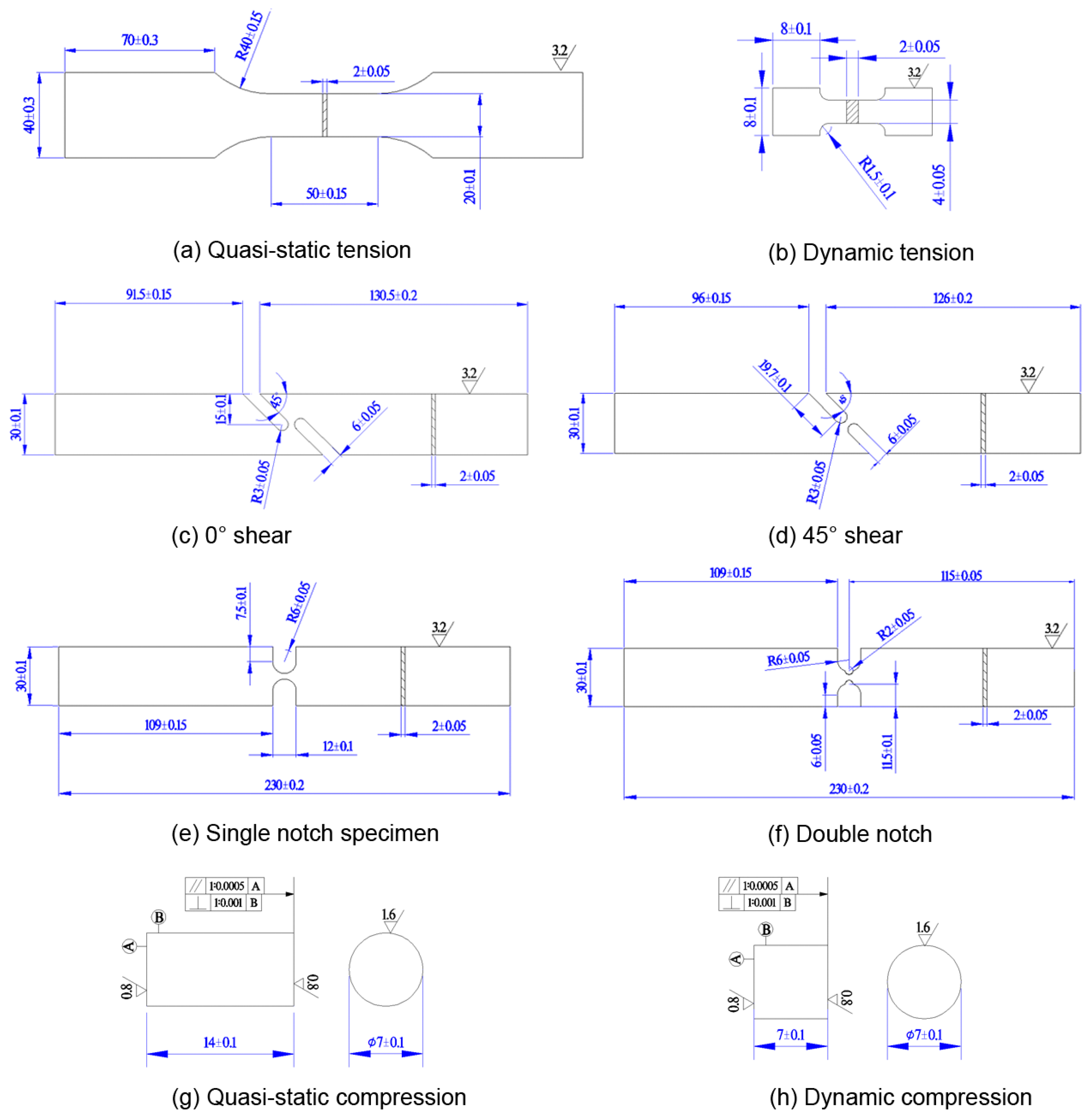

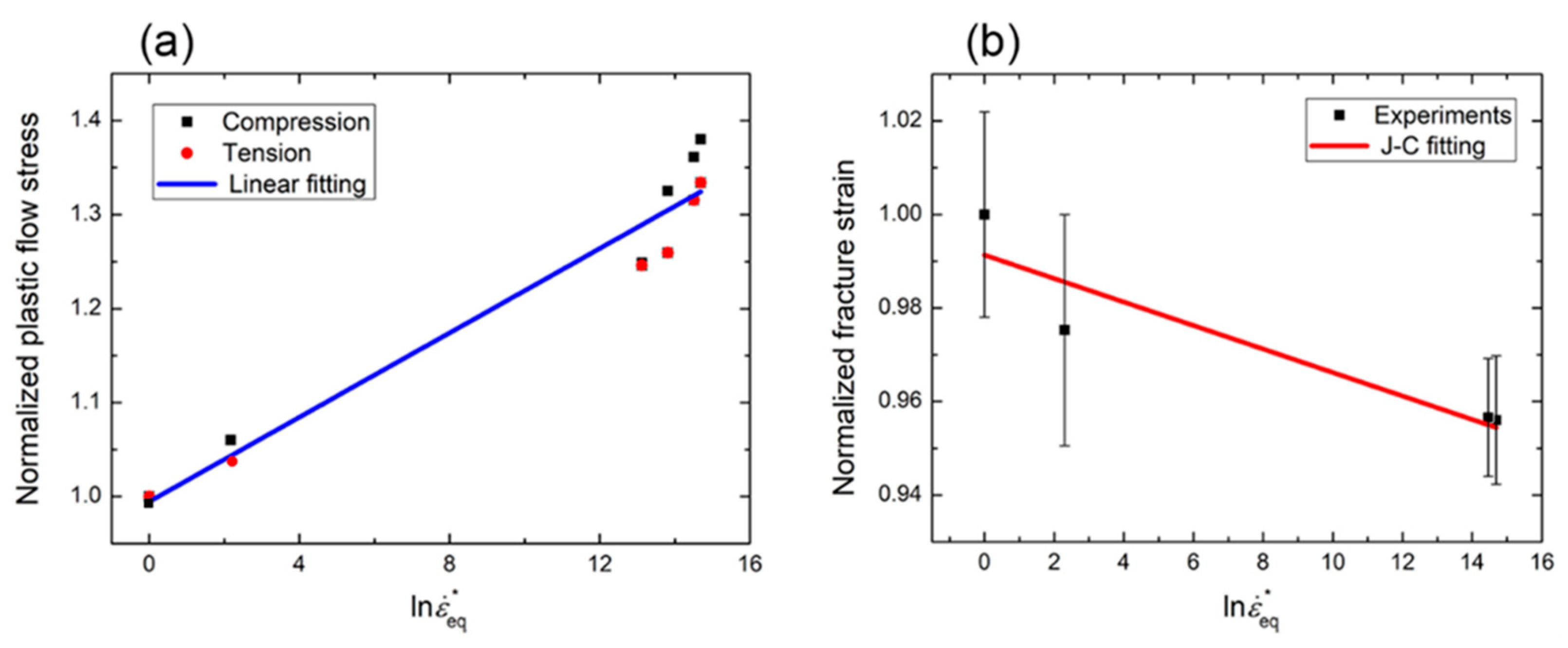

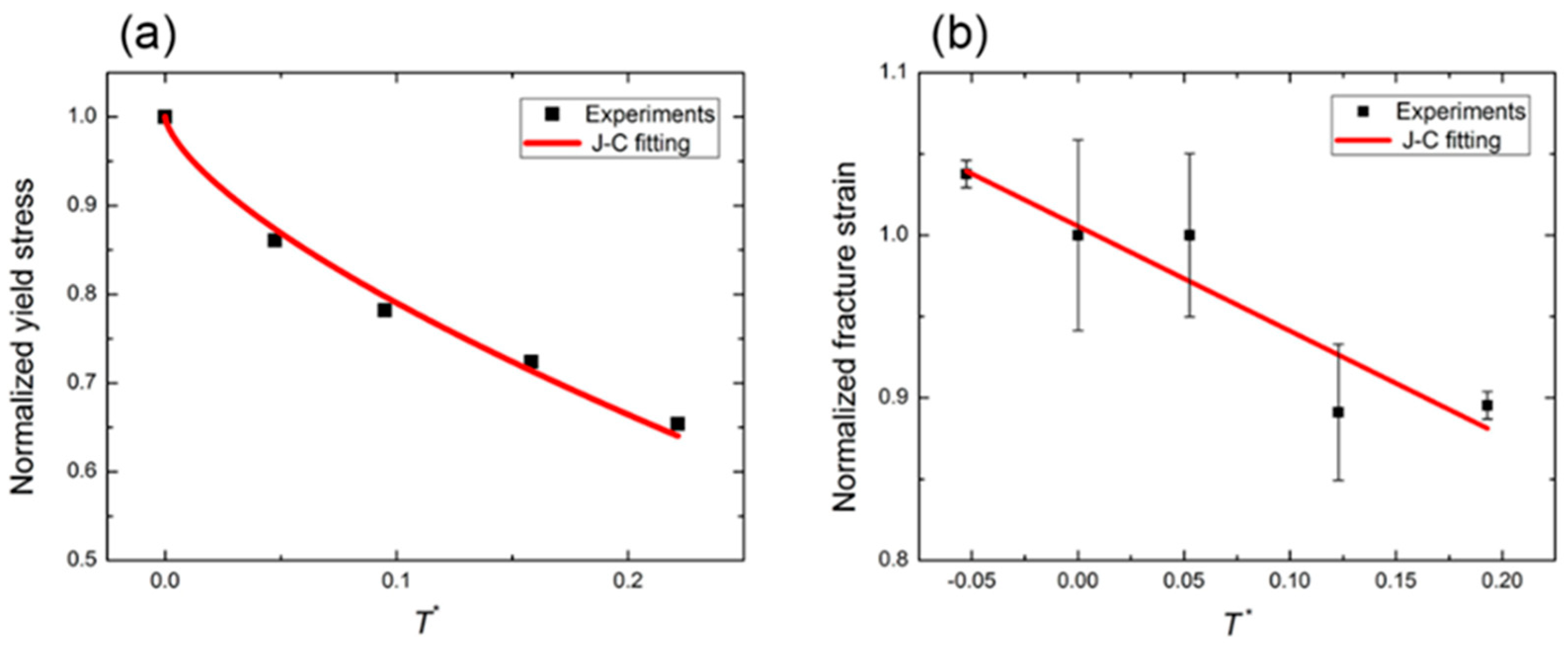
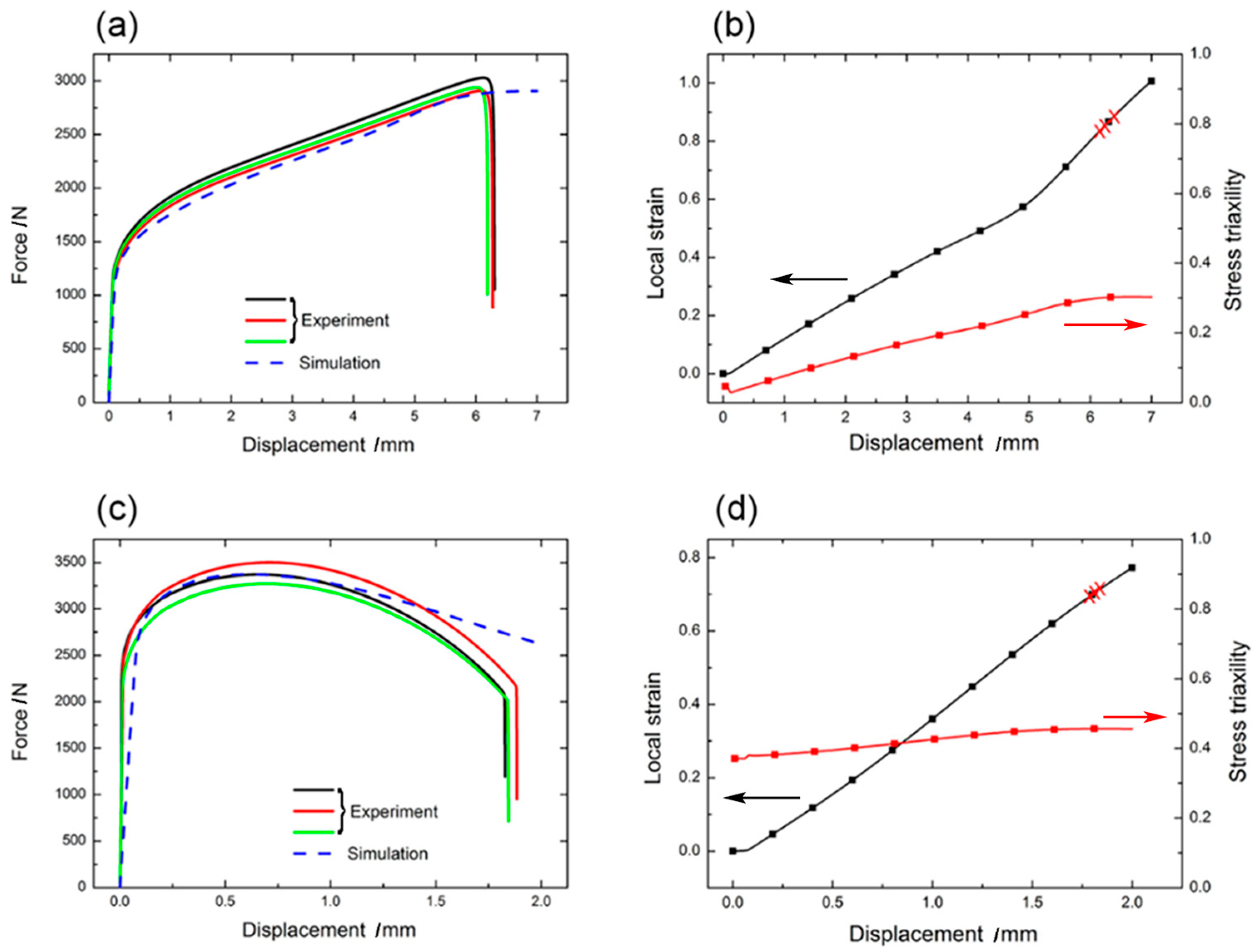



| Composition (wt. %) | C | Si | Mn | P | S | V | Ti |
| 0.18 | 0.45 | 1.45 | 0.03 | 0.02 | 0.18 | 0.12 |
| Material | A/MPa | B/MPa | n | C | m | D1 | D2 | D3 | D4 | D5 |
|---|---|---|---|---|---|---|---|---|---|---|
| Q345C steel | 374 | 510 | 0.41 | 0.052 | 0.679 | 0.028 | 1 | −0.916 | −0.006 | −0.644 |
| 45 steel | 507 | 320 | 0.28 | 0.064 | 1.06 | 0.100 | 0.76 | 1.57 | 0.005 | −0.84 |
Disclaimer/Publisher’s Note: The statements, opinions and data contained in all publications are solely those of the individual author(s) and contributor(s) and not of MDPI and/or the editor(s). MDPI and/or the editor(s) disclaim responsibility for any injury to people or property resulting from any ideas, methods, instructions or products referred to in the content. |
© 2024 by the authors. Licensee MDPI, Basel, Switzerland. This article is an open access article distributed under the terms and conditions of the Creative Commons Attribution (CC BY) license (https://creativecommons.org/licenses/by/4.0/).
Share and Cite
Hu, F.; Liu, X.; Wang, B.; Xiang, Y. Investigations on the Johnson-Cook Constitutive and Damage-Fracture Model Parameters of a Q345C Steel. Metals 2024, 14, 509. https://doi.org/10.3390/met14050509
Hu F, Liu X, Wang B, Xiang Y. Investigations on the Johnson-Cook Constitutive and Damage-Fracture Model Parameters of a Q345C Steel. Metals. 2024; 14(5):509. https://doi.org/10.3390/met14050509
Chicago/Turabian StyleHu, Fengquan, Xin Liu, Boshi Wang, and Yong Xiang. 2024. "Investigations on the Johnson-Cook Constitutive and Damage-Fracture Model Parameters of a Q345C Steel" Metals 14, no. 5: 509. https://doi.org/10.3390/met14050509




